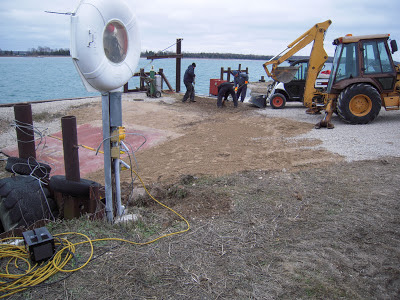 |
| Bench on Gills Rock ferry dock. (Purinton photo) |
Weather this time of year swings between snow and freezing cold, bright sunshine and clouds, wind and calm. Of course, the general trend is cooler, both by day and night. One week ago, Friday Nov. 23, heavy water, solid at times, flew over the pier and nearby buildings in gale force winds. Ice formations were left behind as the temperature dropped and winds diminished. (Before that, everything within 75 feet of the sheet piling was awash.)
This is also the time of year when many birds have begun their southward migration. We're not exactly sure why this peregrine falcon chose to rest near the ferry terminal on Washington Island. Sightings are not uncommon to Wisconsin, but on the other hand, the presence of such a bird was an event. The photo below was taken by Margaret Young with a telephoto lens during the noon hour, Monday the 26th, after the bird was first spotted sitting high in the cottonwood tree south of the ferry terminal by Bill Jorgenson. (I also took photos, but I didn't have the lens power of Margaret's camera.)
 |
| Peregrine falcon. (Margaret Young photo) |
The annual December Washington Island bird count will take place Friday, December 14th, at which time sightings of all birds will be recorded by birders who actively spend their day spotting and counting various birds. Counts are made in the outdoors as well as from kitchen windows overlooking hedges and feeders, and they will include several days prior to and after this calendar date, as I understand it. Contact Sandy Peterson if you'd like to participate and contribute your sightings.
 |
| Bald eagles in Detroit Harbor. (Margaret Young photo) |
Water levels were perhaps more serious than I had first believed, as I had expressed in my blog of Monday, November 26th.
I was reminded that our lake level as of Monday was measured at -21" from the Low Water Datum benchmark. This would mean that, given the -14 ft. LWD charted depth in the Detroit Harbor channel, our operating depth on Monday would have been 12'3". Since our winter ferry draws slightly over 11 ft. loaded, and more "squat" when power is added, this means roughly one foot of water to play with under keel, hardly enough to feel comfortable when operating the Arni J. Richter in the channel. The Army Corps predicts perhaps another 5 inches of loss could be measured before we get into mid-January.
It is for that reason the work has been done at the Potato Dock in preparation for its use. Our crews loaded a heavy semi truck driven by Paul Novak over the bow of the Eyrarbakki on the 27th (Tuesday). This was a trial run to see if there was sufficient room to swing the truck in line for loading, and also to determine if the height of ramp would prove workable. This exercise went well. However, it needs to be said that the stern of the Eyrarbakki was but a few feet from a shoal area. In order to safely perform this maneuver with the longer hull of the Arni J. Richter once ice is in the vicinity, an area dredged to maneuvering depth (at least -15 ft.), outward 100 feet or more from the pier face will be needed.
That is why, until dredging is accomplished, we are anticipating the Arni J. will have to load from the side ramp only. Remember, this is the scenario only when there is ice and the Arni J. Richter is the ferry that must be used. Warm weather in December and early January could extend the period of operation for both the Eyrarbakki and Washington, allowing more time for this area to be dredged.
In the photo below, Rich Ellefson, Jim Hanson and Con McDonald complete grading after burying an electrical conduit in the dock. When connected, this line will bring electrical power to the hydraulic lift mechanism at the adjustable ramp, as well as power for lighting and other uses. The pier in general and the approaches to this ramp were graded and graveled during the past four days, creating a smoother surface for autos.
There is no getting around the fact this pier will be used during the coming winter. The question becomes, how soon will that shift take place, and when the move is made from the normal ferry landings near the terminal building, what loading options will be available?
- Dick Purinton

E.jpg)














